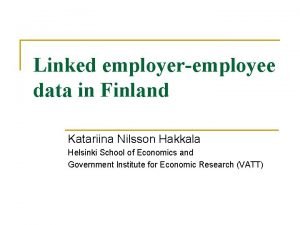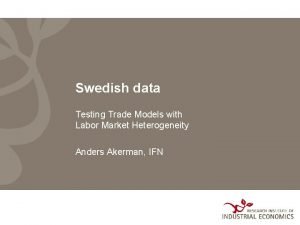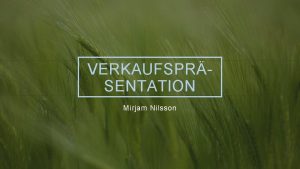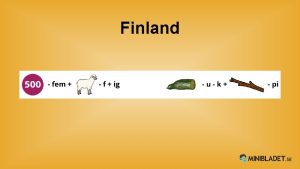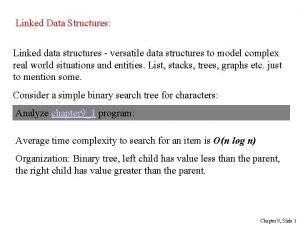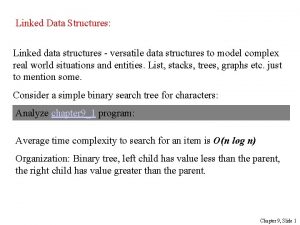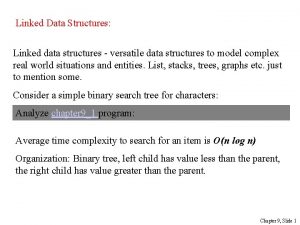Linked employeremployee data in Finland Katariina Nilsson Hakkala












- Slides: 12

Linked employer-employee data in Finland Katariina Nilsson Hakkala Helsinki School of Economics and Government Institute for Economic Research (VATT)

Background n n In recent years linked data sets have become available in many countries Nordic countries have some advantages in constructing such data sets q q q n Centralized nature of statistical systems Unique social security numbers for individuals available in all registers Small populations of employers and workers The first Finnish data as part of ”The Economic Crisis of the 1990’s Project” of the Academy of Finland

FLEED n n Finnish longitudinal Employer-Employee Data of Statistics Finland Worker data 1988 -2005 q q Cross-sections from the Employment Statistics Information merged from over 20 administrative registers All individuals with a permanent residence in Finland Socio-demographic background, annual incomes, periods of unemployment, training courses, etc. , spouse id, and plant/firm id.

FLEED n Plant-level data q q n Business Register Data 1982 -2005 for all industries, only basic information (location, size, turnover) More detailed information for manufacturing plants for 1974 -2005 from the Industrial Statistics Survey (R&D etc) Firm-level 1982 -2004 q Financial Statement statistics n n n q Annual survey for manufacturing, construction, trade, business services and transport 1982 -1995/1996: all large firms+ a stratified sample of smaller firms rotated over time 1996/1997 - : all firms above a certain size threshold Business Tax Register n Administrative data for all firms from 1994 onwards (share of foreign ownership included)

FLEED n Entire data available at research Laboratory of Statistics Finland q n Start-up fee 910 € for each project + 18 € per hour spent at the laboratory Demo version of the FLEED q q q Can be used outside the Statistics Finland For preliminary analysis and testing programs, not for final analysis Firm/plant data n n n Information on region and legal of firm/plant deleted, only less detailed industry code All large firms excluded, noise added to the data of mediumsized firms In the restricted demo to be used outside Finland only every third enterprise is included in the enterprise sample.

FLEED n Worker data: q q q The demo data includes a 1 200 000 sample of the working-age population (15 -70 years) appearing in the FLEED data in some year. For these persons information on the available variables is included for all years 1988– 2004. Region and disability status dropped; education, income variables and dates at a less detailed level About establishments the person level demo data only show the size category, rough area information and rough industry grouping. (worker flows can be computed)

Data from Employers’ Confederation (EK) n n n Wage data for all employees of member firms One survey about white-collar workers and two about blue-collar workers Detailed information on wages, working time (hours), occupations (job titles), job complexity level, and some additional background information Financial statement information about employer characteristics can be matched, employer id available Somewhat selective (larger firms over-represented)

Trade data from Finnish customs n n Firm-level trade data collected by customs matched to FLEED will be available Import and export of goods according to Combined Nomenclature CN Country of origin (imports) and destination (exports) Strict confidentiality, a demo version for external use, final regressions run by Statictics Finland

Some studies using FLEED n n Quite few studies in international trade using FLEED has been used mainly in studies in labor economics, e. g. q q Kyyrä and Wilke (2007, JEEA) ”Reduction in the long-term unemployment of the elderly: A success story from Finland Korkeamäki and Uusitalo (2008, International Tax and Public Finance): Employment and wage effects of a payroll-tax cut: Evidence from a regional experiment

Some studies using FLEED n n n Pesola (2008 unpublished manuscript) “Labour Market Transitions Following Foreign Acquisitions” The job separation hazard increases in the year following a foreign or domestic acquisition in the industrial sector In the case of foreign acquisitions the probability of changing jobs increases more than the probability of moving to nonemployment.

Some studies using FLEED n n Pesola (2007 HECER wp) “Foreign Ownership, Labour Mobility and Wages” Analyse the extent to which employees benefit from knowledge they acquire in foreign owned firms and whether educational background makes a difference in this process. q q Highly educated employees earn a return to prior experience in a foreign owned firm, over and above the return to other previous experience. Foreign owned firms do not pay a premium for knowledge that workers bring with them from domestic firms i. e. “reverse spillovers”

Some studies using EK data n Kilponen and Santavirta (2008 unpublished manuscript) study implicit wage contracting in the Finnish labour markets by employing variations of the standard wage curve. q q Find evidence for the negative wage-current unemployment elasticity, i. e. support for the standard wage curve The importance of import competition weakens the impact on the wage-unemployment elasticities.
